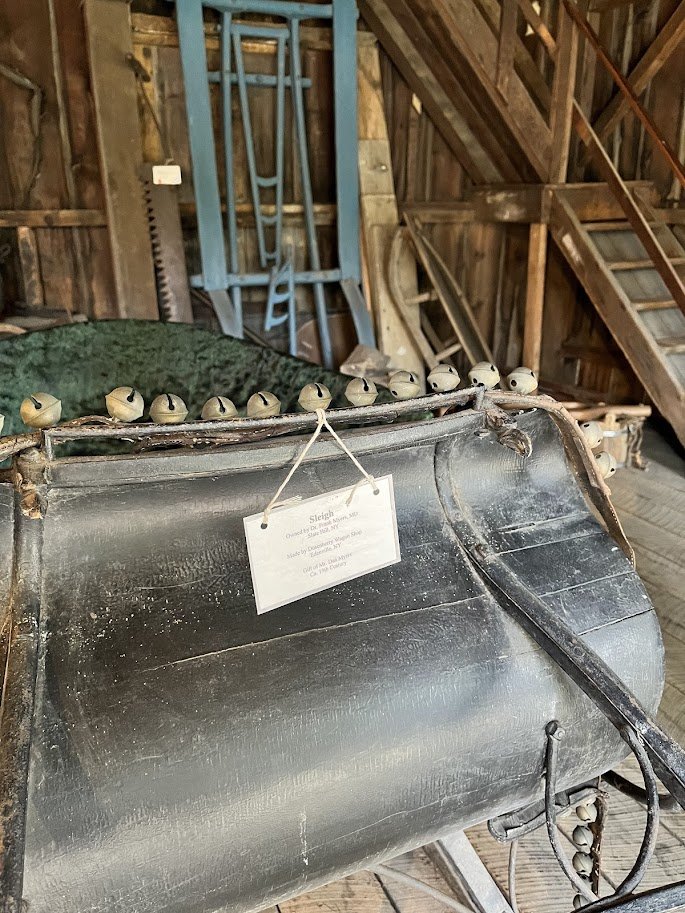
The Hasbrouck Carriage House
Originally built in the early 1800s by James Hoyt on land previously owned by Francis Baird, The Hasbrouck Carriage House is named after its last private owner, Miss Hylah Hasbrouck.
In 1967, the property was purchased and renovated by Chester National Bank (later Key Bank), during which time four shoes of varying sizes and the skeleton of a cat were discovered within the structure—symbols of good luck in the English tradition. One of these shoes is periodically displayed in the 1810 Gallery.
Threatened with demolition in 1998, the carriage house was offered to the Warwick Historical Society if they could relocate it at their expense. Thanks to dedicated craftsmanship, it was carefully dismantled, marked with chalk notations, and rebuilt on a new foundation, where it stands today behind the Baird’s Tavern.
Read more details on how the Society acquired this structure HERE in the 1998 issue of the WHS annual newspaper Warwick Roots.
First Floor
The first floor remains much as it did when carriages and agricultural equipment filled its space. It is a favorite stop on the WHS’s annual 4th Grade Tours and Open House Event. It serves as a hands-on learning opportunity for students and visitors alike.
A guessing game helps students discover early agricultural instruments.
This miniature carriage was designed for children to pull their dolls or toys, mimicking the adult world of horse-drawn travel. Often a gift, these small wagons were both a plaything and a way for young children—especially girls—to practice nurturing and caretaking through imaginative play.
A corn sheller from the mid-1800’s is a mechanical device for pulling dried kernels from the cob.
An Open Sleigh, reminiscent of “a one-horse open sleigh,” once used for winter travel, paired with heavy wool blankets for warmth. Behind, blue-painted sled for hauling ice blocks to storage houses. Separated by straw, the ice helped preserve food well into warmer months.
A Tribute to Warwick’s Medical Legacy
Step upstairs into a re-creation of a doctor’s office from nearly a century ago—an intimate tribute to the generations of Bradner family physicians who helped shape the health and wellbeing of Warwick.
This exhibit was made possible through a generous donation from Mary Bradner in honor of her husband, Dr. Morris Renfrew “Bud” Bradner, Jr., and his father, Dr. Morris Renfrew “Buck” Bradner. Together with earlier Bradner relatives, including Drs. Henry and William Freeman Ketchum Bradner, the family’s legacy spans four generations and continues today through their descendant, Dr. Melissa Bradner Wyllie.
The second floor features three rooms that transport visitors to a working medical practice from the early 20th century.
Second Floor
Waiting Room: Styled with vintage furnishings, it offers a glimpse into the calm before the consultation.
Consultation Room: Where physicians would meet patients, review notes, and assess symptoms.
Treatment Room: Complete with an authentic examination table and medical equipment from the era.
A remarkable collection of well-preserved medical instruments and patient care items is thoughtfully displayed, offering a rare glimpse into the tools and techniques of 19th early 20th-century medicine.
Bradner Family Highlights
Dr. Henry Freeman Ketchum Bradner (1847–1931) introduced Warwick’s first X-ray machine, served as the town’s health officer, and remained a key figure in local medicine until the end of WWI.
Dr. Morris Renfrew “Buck” Bradner (1889–1963) served in WWI and worked with the American Red Cross in Serbia before returning to Warwick, where he helped establish both of the town’s earliest hospitals.
Dr. Morris “Bud” Bradner, Jr. continued the family tradition of care into the late 20th century.
This second-floor exhibit is a heartfelt reminder of how one family’s dedication to healing helped shape a healthier, stronger Warwick.
Read Dr. M. Bradner Jr’s obituary HERE in the 1992 issue of Warwick Roots.














